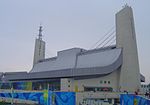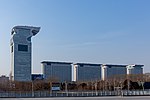China Ethnic Museum

The China Ethnic Museum (中华民族博物馆; pinyin: Zhōnghuá Mínzú Bówùguǎn; also called Chinese Ethnic Culture Park, 中华民族园; pinyin: Zhōnghuá Mínzú Yuán) is a museum in Beijing, China, located just to the west of the Olympic Green. It features displays of the daily life and architecture of China's 56 ethnic groups. As stated on its website, the museum's goals are as follows: To demonstrate ethnic architecture To preserve ethnic relics To spread ethnic knowledge To study ethnic heritage To enhance ethnic culture To promote unity of all Chinese ethnic groupsConstruction began in October 1992. The North Section was opened to the public on June 18, 1994, and the South Section was opened in September 2001. Construction has continued through the 2008 Summer Olympics. The museum covers approximately 50 hectares and so far comprises 44 ethnic villages and 200 ethnic buildings. There are 800 staff members comprising various Chinese ethnic groups. All buildings are constructed to a ratio of 1:1. At the museum, several ethnic groups grow traditional crops such as paddy rice or buckwheat, and each day Tibetan lamas from the Tar Monastery of Qinghai chant Buddhist sutras. The museum has also collected approximately 100,000 cultural relics, and exhibits items representing the daily life of China's ethnic groups. The museum's curator is Wang Ping.
Excerpt from the Wikipedia article China Ethnic Museum (License: CC BY-SA 3.0, Authors, Images).China Ethnic Museum
Aotizhong lu, Chaoyang District Yayuncun
Geographical coordinates (GPS) Address Nearby Places Show on map
Geographical coordinates (GPS)
| Latitude | Longitude |
|---|---|
| N 39.983888888889 ° | E 116.39027777778 ° |
Address
国家奥林匹克体育中心
Aotizhong lu
100012 Chaoyang District, Yayuncun
Beijing, China
Open on Google Maps








